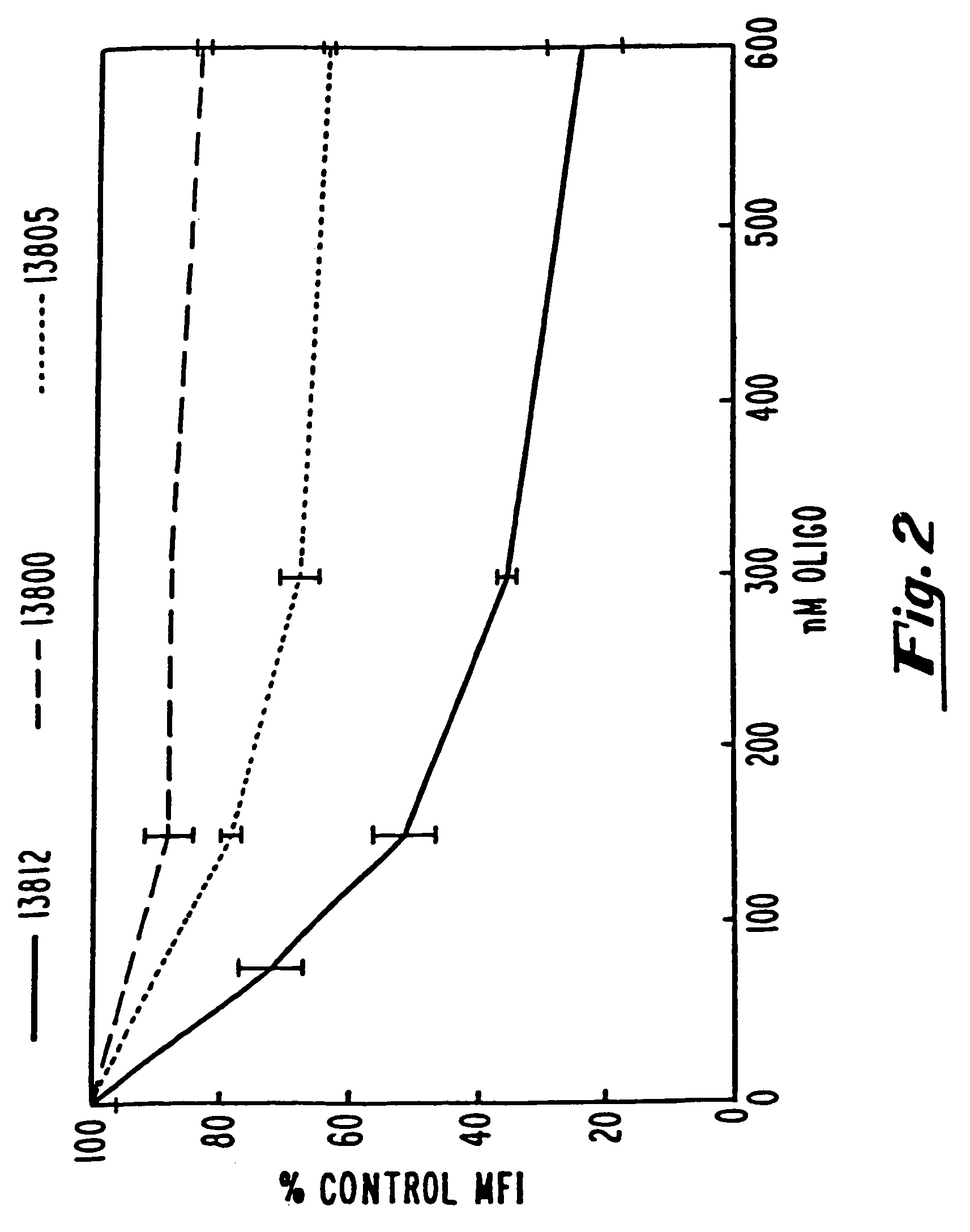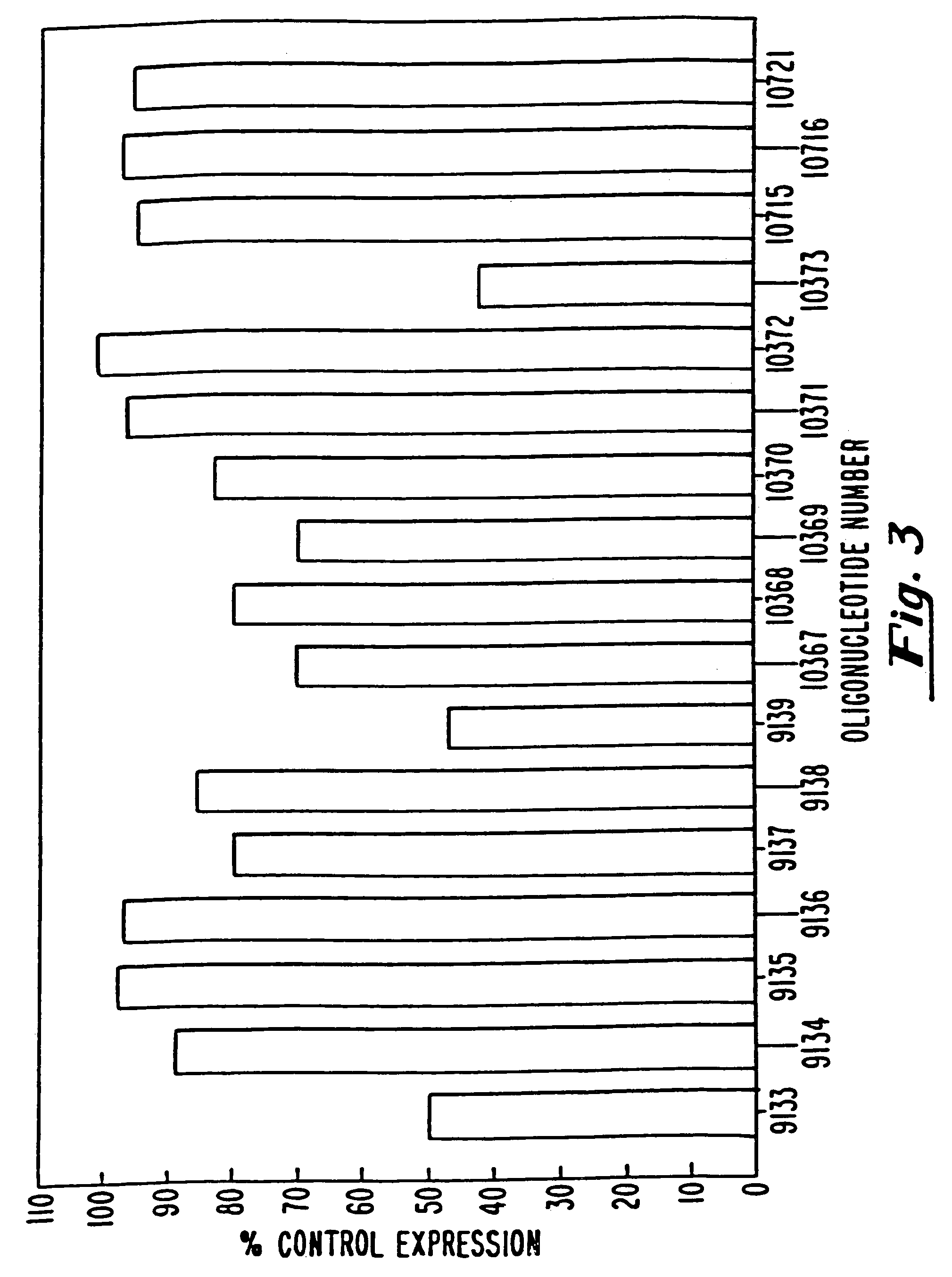Oligonucleotide compositions and methods for the modulation of the expression of B7 protein
a technology of b7 protein and composition, which is applied in the field of diagnostics, research reagents and therapeutics, can solve the problems of no known therapeutic agents effective regulation, damage to normal tissue, and no known therapeutic agents, and achieve the effects of inhibiting t cell activation and proliferation, and enhancing expression of other alternatively spliced b7 mrnas
- Summary
- Abstract
- Description
- Claims
- Application Information
AI Technical Summary
Benefits of technology
Problems solved by technology
Method used
Image
Examples
example 1
Synthesis of Nucleic Acids Oligonucleotides
[0227]Oligonucleotides were synthesized on an automated DNA synthesizer using standard phosphoramidite chemistry with oxidation using iodine. β-Cyanoethyldiisopropyl phosphoramidites were purchased from Applied Biosystems (Foster City, Calif.). For phosphorothioate oligonucleotides, the standard oxidation bottle was replaced by a 0.2 M solution of 3H-1,2-benzodithiole-3-one-1,1-dioxide in acetonitrile for the stepwise thiation of the phosphite linkages. The thiation cycle wait step was increased to 68 seconds and was followed by the capping step.
[0228]The 2′-fluoro phosphorothioate oligonucleotides of the invention were synthesized using 5′-dimethoxytrityl-3′-phosphoramidites and prepared as disclosed in U.S. patent application Ser. No. 463,358, filed Jan. 11, 1990, and Ser. No. 566,977, filed Aug. 13, 1990, which are assigned to the same assignee as the instant application and which are incorporated by reference herein. The 2′-fluoro oligo...
example 2
Modulation of hB7-1 Expression by Oligonucleotides
[0272]The ability of oligonucleotides to inhibit B7-1 expression was evaluated by measuring the cell surface expression of B7-1 in transfected COS-7 cells by flow cytometry.
Methods:
[0273]A T-175 flask was seeded at 75% confluency with COS-7 cells (ATCC accession No. CRL 1651). The plasmid pcB7-1 was introduced into cells by standard calcium phosphate transfection. Following a 4 hour transfection, the cells were trypsinized and seeded in 12-well dishes at 80% confluency. The cells were allowed to adhere to the plastic for 1 hour and were then washed with phosphate-buffered saline (PBS). OptiMEM™ (GIBCO-BRL, Gaithersburg, Md.) medium was added along with 15 μg / mL of Lipofectin™ (GIBCO-BRL, Gaithersburg, Md.) and oligonucleotide at the indicated concentrations. After four additional hours, the cells were washed with phosphate buffered saline (PBS) and incubated with fresh oligonucleotide at the same concentration in DMEM (Dulbecco et al...
example 3
Modulation of hB7-2 Protein by Oligonucleotides
[0276]In an initial screen, the ability of hB7-2 oligonucleotides to inhibit B7-2 expression was evaluated by measuring the cell surface expression of B7-2 in transfected COS-7 cells by flow cytometry. The methods used were similar to those given in Example 2, with the exceptions that (1) COS-7 cells were transfected with the plasmids pbcB7-2 or BBG-58, a human ICAM-1 (CD54) expression vector (R&D Systems, Minneapolis, Minn.) introduced into cells by standard calcium phosphate transfection, (2) the oligonucleotides used were those described in Table 2, and (3) a conjugated anti-B7-2 antibody (i.e., anti-hCD86-FITC or anti-CD86-PE, PharMingen, San Diego, Calif.; PE: phycoerythrin) was used during flow cytometry.
Results:
[0277]The results are shown in FIG. 3. At a concentration of 200 nM, ISIS 9133, ISIS 9139 and ISIS 10373 exhibited inhibitory activity of 50% or better and are therefore highly preferred. These oligonucleotides are targete...
PUM
 Login to View More
Login to View More Abstract
Description
Claims
Application Information
 Login to View More
Login to View More - R&D
- Intellectual Property
- Life Sciences
- Materials
- Tech Scout
- Unparalleled Data Quality
- Higher Quality Content
- 60% Fewer Hallucinations
Browse by: Latest US Patents, China's latest patents, Technical Efficacy Thesaurus, Application Domain, Technology Topic, Popular Technical Reports.
© 2025 PatSnap. All rights reserved.Legal|Privacy policy|Modern Slavery Act Transparency Statement|Sitemap|About US| Contact US: help@patsnap.com



